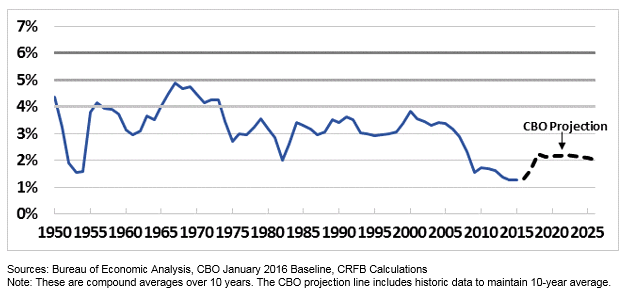Fact Sheet: How Much Can the Economy Grow?
Since faster economic growth would represent a boon for wages and the fiscal situation, a number of Presidential candidates have been promising or assuming it on the campaign trail. For example:
- Ted Cruz: “America can get to 5 percent growth.”
- Donald Trump: “We are looking at a 3 percent but we think it could be 5 [percent] or even 6 [percent]. We are going to have growth that will be tremendous”.
- Analysis supported by campaign staff of Bernie Sanders: “The growth rate of the real gross domestic product will rise from 2.1% per annum to 5.3%”
These diverge quite substantially from projected growth and even economic history:
- The Congressional Budget Office (CBO) projects real (inflation-adjusted) growth will average 2.1 percent over the next decade.1 The Blue Chip projection is for 2.2 percent.2
- Since 1947, the average rate of US economic growth has been 3.2 percent; growth is expected to be about 1 percent lower than that due to slower labor force growth (mainly from population aging).3
Figure: 10-Year Average Real GDP Growth By End Year (Rolling Average) 
- In the post-war era, there has never been a period of 10 consecutive years that have averaged 5 percent GDP growth.
- The record was 4.9 percent from 1958 to 1967 (due to recovery from the 1958 recession, the post-war economic boom, and the Kennedy-era tax cuts in 1964)
- Since 1973, there has not been a 10-year period that has averaged even 4 percent growth.
- The contemporary example of a booming economy, the technological revolution of the 1990s, averaged about 3.5 percent growth – driven in part by demographics and a dot-com bubble.
- Adding together all pro-growth policies estimated by the official scoring agencies would at most increase annual economic growth to about 3 percent.4
###
For more information or to speak with a CRFB expert, contact media@crfb.org.
1 CBO projects the economic situation assuming a current law baseline in which Congress meets its obligations but does not change the law. For the purposes of this short analysis, growth refers to real (inflation-adjusted) Gross Domestic Product (GDP) growth, considered widely to be the most relevant measure of the size of the economy.
2 The Blue Chip projection is an average of 50+ independent macroeconomic forecasts that vary by modeling method and assumptions. https://www.wklawbusiness.com/product-family/blue-chip
3 Simple average of the annual growth rates from 1948 to 2015.
4 Tax reform will likely only be able to increase growth by 0.02 to 0.5 percent per year, according to official estimates from the Joint Committee on Taxation and the Treasury Department. According to CBO’s most recent estimate, repealing the Affordable Care Act could increase growth by less than 0.1 percent per year. CBO estimated that the Senate’s immigration reform bill in 2013 could increase growth by up to 0.3 percent a year. In CBO’s long-term budget outlook, they calculate that a $4 trillion deficit reduction package would have positive economic returns of around 0.1 percent yearly on, average, over ten years. In total this could add about 1 percentage point to the growth rate that CBO projects of about 2.1 percent, bringing average growth to around 3 percent.


